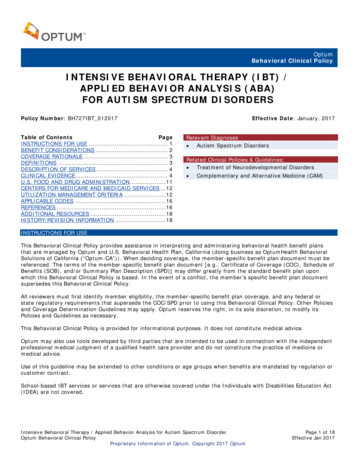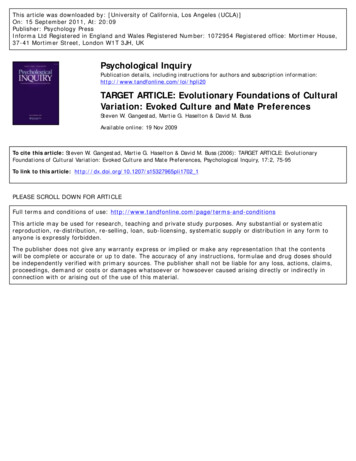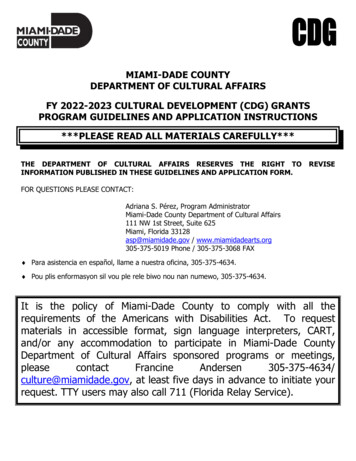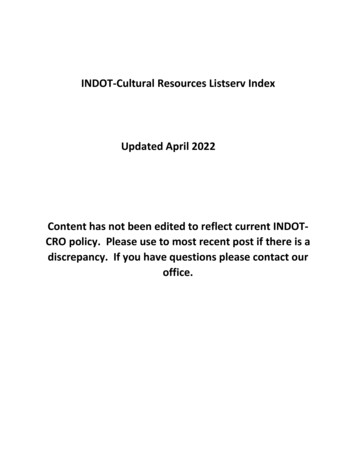
Transcription
An Intensive Cultural Resources Survey for theProposed ExxonMobil Baytown OlefinsPlant Ethylene Expansion Unit ProjectHarris County, Texas
Document No. 120112Job No. 100030414AN INTENSIVE CULTURAL RESOURCES SURVEY FOR THEPROPOSED EXXONMOBIL BAYTOWN OLEFINS PLANTETHYLENE EXPANSION UNIT PROJECTHARRIS COUNTY, TEXASPrepared for:ExxonMobil Chemical CompanyBaytown Olefins Plant3525 Decker DriveBaytown, Texas 77520Prepared by:Atkins1250 Wood Branch Park Drive, Suite 300Houston, Texas 77079Principal Investigator:Dale NortonReport Author:Karen BelvinMarch 2013with contributions by:Brandy Harris
AbstractExxonMobil Chemical Company (ExxonMobil) has submitted an application requesting authorization of greenhouse gas emissions to the U.S. Environmental Protection Agency Region 6 (EPA).Atkins North America, Inc. (Atkins) has been contracted by ExxonMobil to perform a culturalresources survey for the Baytown Olefins Plant Ethylene Expansion Unit Project.In August and October 2012, Atkins conducted an intensive cultural resources survey of10 hectares (25 acres) for the proposed BOP Ethylene Expansion Unit Project in eastern HarrisCounty, Texas. The survey was performed at the request of ExxonMobil to identify the existence ofany as yet unidentified cultural resources for the proposed BOP Expansion Project. The surveyconsisted of a surface inspection augmented by subsurface shovel testing and a historic-agenonarcheological resources survey of the proposed project footprint as this was defined as the areaof potential effects. The visual area of potential effects (VAPE) extends 1.5 miles from the footprint.An intensive VAPE survey was conducted within 300 feet of the footprint and a windshield VAPEsurvey was conducted from 300 feet to 1.5 miles from the footprint to identify any historic(National Register of Historic Places [NRHP]-eligible) nonarcheological resources that could beindirectly affected by the proposed project.During the initial phase of the surface inspection, concrete (Section A), decomposing pond silt(Section B), and construction fill (Section D) was identified at the ground surface. This, along withongoing pipeline construction and installation activities within the project area precludedimplementation of minimum survey standards as outlined by the Texas Historical Commission.Consequently, subsurface inspection efforts were focused on portions of the project area wherepenetrable and undisturbed soils were identified (Section C). All sections of the project area werevisually inspected and a total of 5 shovel tests were excavated. No prehistoric or historicarcheological sites were identified within the project area and no artifacts were observed, collected,or curated as a result. Subsequent to the historical-age resources survey, one potentially eligibleNRHP historic-age nonarcheological resource was identified within the broader VAPE.In light of the extensive amount of previous and on-going mechanical disturbances, presence ofconcrete, pond silt, construction fill, and impenetrable clay, and absence of cultural material withinthe proposed project area, Atkins recommends that cultural resources consultations be consideredcomplete for the project presented in this report. Additionally, the proposed project does notappear to possess the potential to adversely impact historic nonarcheological resources. As a result,Atkins recommends that the proposed plant expansion of the ExxonMobil BOP activities be allowedto proceed without further consultation.100030414/120112ii
ContentsPageAbstract . iiList of Figures . vI. INTRODUCTION. 1II. NATURAL ENVIRONMENT . 5NATURAL ENVIRONMENT . 5Physiography . 5Geology . 5Soils. 6Beaumont Series . 6Climate. 6III. CULTURAL SETTING . 9CULTURAL SEQUENCE. 9Prehistory of the Vicinity . 9Early Paleoindian Period (10,000–8000 B.C.) . 9Archaic Period (8000 B.C.–A.D. 400) . 10Late Prehistoric (A.D. 400–1519) . 11History of the Vicinity . 11Historic Period (A.D. 1519–1900) . 11European Contact and Anglo-American Settlement . 12Historic Land Use. 14PREVIOUS CULTURAL RESOURCES INVESTIGATIONS . 15Records Review . 15Previous Investigations . 15IV. SURVEY METHODS AND RESULTS . 17FIELD INVESTIGATION METHODS . 17SURFACE INSPECTION. 17SUBSURFACE INSPECTION . 20FIELD INVESTIGATIONS RESULTS . 20V. HISTORIC-AGE NONARCHEOLOGICAL RESOURCES . 21HISTORIC-AGE NONARCHEOLOGICAL RESOURCES SURVEY METHODS . 21GENERAL PROJECT AREA DESCRIPTION: BUILT ENVIRONMENT . 25HISTORIC-AGE NONARCHEOLOGICAL RESOURCE SURVEY RESULTS ANDRECOMMENDATIONS. 27The Bayvilla Neighborhood . 27Additional Historic-Age Neighborhoods . 28Other Historic-age Nonarcheological Resources . 29VI. CONCLUSIONS AND RECOMMENDATIONS . 31100030414/120112iii
ContentsPageREFERENCES CITED . 32Appendices:AProject Area PhotographsBHistoric-age Nonarcheological Resources PhotographsCRésumé for Dale Norton100030414/120112iv
ContentsFiguresPage123456789Project Vicinity Map. 2Project Location Map . 3Previous Projects Map . 16Mechanically Disturbed Area Map . 18Subsurface Inspection Map . 19Historic-age Nonarcheological Resources Area of Potential Effects and ResourceLocation Map . 22Setting Photograph Location Map . 23Historic Representations of the Project Vicinity: 1920, 1944, 1955, and 1967 Map . 24Modern Development in the VAPE Map. 26100030414/120112v
I. INTRODUCTIONExxonMobil Chemical Company (ExxonMobil) has submitted an application requesting authorization of greenhouse gas emissions to the U.S. Environmental Protection Agency Region 6 (EPA).Atkins North America, Inc. (Atkins) has been contracted by ExxonMobil to perform a culturalresources survey for the Baytown Olefins Plant Ethylene Expansion Unit Project (Figure 1).ExxonMobil Baytown is a petrochemical complex that consists of a refinery, chemical plant, andOlefins Plant (BOP). The proposed project will include expansion of the BOP Ethylene facility withinthe existing ExxonMobil complex. The project area is located within the USACE’s Galveston Districtand can be found on the U.S. Geological Survey (USGS) 2012 Highland 7.5-minute seriestopographic quadrangle map.In August and October 2012, Atkins conducted an intensive cultural resources survey of10 hectares (ha) (25 acres) for the proposed BOP Ethylene Expansion Unit Project in eastern HarrisCounty, Texas. The survey consisted of a surface inspection augmented by subsurface shovel testingand a historic-age nonarcheological resources survey of the proposed project footprint as this wasdefined as the area of potential effects. The visual area of potential effects (VAPE) extends 1.5 milesfrom the proposed project’s footprint. An intensive VAPE survey was conducted within 300 feet ofthe footprint and a windshield VAPE survey was conducted from 300 feet to 1.5 miles from thefootprint to identify any historic (National Register of Historic Places [NRHP]-eligible)nonarcheological resources that could be indirectly affected by the proposed project. All portionsof the project area were visually inspected. The field investigation was conducted by ProjectArcheologist Karen Belvin and Historian Brandy Harris under the direction of Principal InvestigatorDale Norton. Approximately 4 person-days of labor were expended during the surveys.The proposed BOP Expansion Project is located in eastern Harris County, Texas and lies betweenthe existing Olefins facility and State Highway (SH) 330 (Figure 2). The acreage for the proposedexpansion project is 10 ha (25 acres). Of the total survey area, approximately 6 ha (16 acres) weresubject to heavy mechanical disturbance for ExxonMobil plant development. Therefore, of the total10 ha (25 acres) surveyed, 4 ha (9 acres) were shovel tested for a total of 5 shovel tests. Noprehistoric or historic archeological sites were identified within the project area and no artifactswere observed, collected, or curated as a result.The objectives of the survey were to (1) locate cultural resources within the survey area,(2) delineate the vertical and horizontal extent of any identified archeological sites, (3) assess theintegrity of identified resources, and (4) provide a preliminary evaluation of each identifiedresource’s potential eligibility for listing in the NRHP and/or designation as a State ArcheologicalLandmark (SAL). The historic resources survey included a broader visual area of potential effects(VAPE) and sought to determine if proposed project activities would adversely affect any historic(NRHP-eligible or listed) resources as defined under Section 106.100030414/1201121
LIBERTYProject LocationHARRISCHAMBERSBRAZORIAG A LV E S T O NFigure 1Project Vicinity MapExxonMobil Chemical CompanyBaytown Olefins Plant Expansion ProjectProject AreaHighlands QuadrangleHarris County,TexasDatum: NAD 1983Projection: UTMZone: 15Units: MeterI02.557.510MilesPrepared By: ATKINS/14923Scale: 1 " 5 MilesJob No.: 100030414Date: Dec 12, 2012N:\Clients\E F\Exxon\100030414\geo\cr vicinity map.mxd2
Figure 2Project Location MapExxonMobil Chemical CompanyBaytown Olefins Plant Expansion ProjectProject Area300' APEHighlands QuadrangleHarris County,TexasDatum: NAD 1983Projection: UTMZone: 15Units: MeterI00.511.532Prepared By: ATKINS/14923MilesJob No.: 100030414Scale: 1 " 1 MileDate: Dec 12, 2012N:\Clients\E F\Exxon\100030414\geo\cr location map.mxd
I. IntroductionThe survey was performed at the request of ExxonMobil and was conducted in compliance with theNational Historic Preservation Act of 1966 (Public Law [PL] 89-665 as amended); the Procedures ofthe Advisory Council on Historic Preservation (36 CFR 800); as well as the guidelines set forth byTexas Historical Commission and the Council of Texas Archeologists.100030414/1201124
II. NATURAL ENVIRONMENTThe proposed BOP Expansion Project area is located in eastern Harris County within the city ofBaytown. It is situated northwest of Loop 201, between Bayway Drive and Decker Drive (SH 330).The environmental setting discussed below includes information on the physiography and geology,and soils, climate, and flora and fauna of the general project area.NATURAL ENVIRONMENTPhysiographyThe project area lies within the Gulf Coastal Plain of Texas. This physiographic province ranges incharacter from a smooth depositional plain boarded by bays and barrier islands along the Gulf ofMexico, to rolling hills extending inland to the Balcones Fault Zone. The plain rises in elevation fromsea level to approximately 197 ft (60 meters [m]) above mean sea level (amsl) within roughly100 miles (161 kilometers [km]) of the Texas Gulf Coast. Narrow corridor valleys of small streamsand broader valleys of larger streams break the generally flat relief of the Gulf Coastal Plain. Saltdomes and fault scarps occasionally interrupt this relatively featureless topographic pattern. Somescattered salt domes express surface features as broad mounds with as much as 98 ft (30 m) ofrelief. Faults are common in the region, but express little or no surface relief (Bureau of EconomicGeology 1996).The landscape within this physiographic province is characterized as broad, nearly level, and gentlysloping coastal prairie with poorly defined drainage patterns. Agricultural industry andurbanization within the Gulf coastal Plain have indelibly changed the landscape. Much of the plain,particularly within the project area, has been cleared for urban and petrochemical development,resulting in many of the natural drainages (e.g., Goose Creek and associated tributaries) havingbeen altered by channelization and dredging (Fenneman 1938).GeologyThe project area overlies the Pleistocene-aged Beaumont Formation, the youngest continuouscoastwise terrace fronting the modern Gulf Coast (Fischer et al. 1972). The origins of this formationare mainly fluvial and deltaic although some areas may have originated as coastal marsh andlagoonal deposits (Wheeler 1976). The Beaumont Formation can be divided into three stratigraphicsubdivisions, the first consisting of clay and mud deposits, the second consisting of clayey sand andsilt deposits, and the last consisting of fine-grained sand (Abbott 2001). The stratigraphicsubdivision of the project area is that of clay and mud deposits.100030414/1201125
II. Natural EnvironmentSoilsSheet 97 of the Soil Survey of Harris County, Texas (Wheeler 1976), depicts the soils of the projectarea. The soils are mapped as the Beaumont Clay, which is listed by Abbott (2001) as having a lowgeoarcheological potential. A brief description of this series is provided below.Beaumont SeriesThe Beaumont Series (Ba) consists of deep, acid, nearly level, clayey soils on upland prairies and areformed in thick beds of alkaline marine clay and are poorly drained. The soils exhibit gilgaimicrorelief, in which the microknolls are 6 to 12 inches higher than the microdepressions. Whendry, Beaumont soils tend to exhibit deep, wide cracks that extend to the surface. During the rainyseason, the cracks quickly fill with water, creating flooding due to very slow runoff, lowpermeability, very slow internal drainage, and high available water capacity. Primary uses ofBeaumont soils are rice cultivation and pasture with regional urban development (Wheeler 1976).The entire project area lies within the Beaumont Clay mapping unit. Abbott (2001) rates thegeoarcheological of Beaumont soils as low. He notes that the soils “are the product of prolongedpedogenesis and the sediments are too old to contain archeological materials in good context.”ClimateThe modern climate of the project area is humid and subtropical. Temperature is regulated byprevailing south-southeasterly Gulf breezes (Arbingast et al. 1976). Summers are generally hot withtemperature rising to over 100 degrees Fahrenheit, most often during July and August. Winters aremild, with January typically the coldest month. Monthly rainfall is evenly distributed throughout theyear and averages between 30 and 60 inches annually. Gulf-generated thunderstorms and tropicalstorms occasionally pass through Harris County and can cause severe damage (Larkin and Bomar1983).Flora and FaunaThe climate and vegetation of the upper Texas coast reflect the latitude, low elevation, andinfluence of proximity to the Gulf of Mexico. The region is bound on the west by the San JacintoRiver, on the east by the Trinity River, and on the north by an arbitrary line that closelyapproximates the southern extent of Caddo settlement (Ensor 1987, 1991). In general, four broadcommunities of vegetation can be identified near the Houston area: Coastal Marsh/Barrier Island,Coastal Prairie, Coastal Gallery Forest, and Pine-Hardwood Forest (McMahan et al. 1984).Coastal Marsh/Barrier Island communities include well-drained sandy coastal environments andsaline and freshwater wetlands near the coast. Salinity, frequency and inundation durations, anddepth of the seasonal water table control the character of vegetation assemblages in these areas100030414/1201126
II. Natural Environment(Abbott 2001:24). Well-drained freshwater environments are dominated by bluestem(Schizachyrium spp. and Andropogon spp.), switchgrass (Panicum virgatum), and Paspalum spp.Marshhay cordgrass (Spartina patens), seashore saltgrass (Distichlis spicata), bulrushes (Scirpusspp.), saltmarsh aster (Aster subulatus), and other sedges and grasses dominate wetter areas.Higher areas are dominated by some of the above-mentioned vegetation and gulfdune paspalum(Paspalum monostyachyum), bushy sea-oxeye (Borrichia frutescens), and glasswort (Salicornia spp.)(Abbott 2001; White and Paine 1992).The most common mammal on the barrier islands is the hispid cotton rat (Sigmodon hispidus), asignificant source of meat for aboriginal inhabitants of Galveston Island (Ricklis 1994). White-taileddeer (Odocoileus virginianus), raccoons (Procyon lotor), and opossum (Didelphis virginiana) are alsocommon to the coastal marsh/barrier island communities, although white-tailed deer are no longerpresent on Galveston Island. Reptilian species include the ornate box turtle (Terrapene ornata),kingsnakes (Lampropeltis spp.), eastern hognose (Heterodon platirhinos), western diamondbackrattlesnake (Crotalus atrox), and cottonmouth (Agkistrodon piscivorus).Coastal Prairies are nearly topographically flat, characterized by clayey soils, and generally only afew meters above sea level. The Coastal Prairie consists primarily of grasses with minor amounts offorbs and wooded plants, and is characteristic of upland areas that are not saturated on a seasonalbasis (Abbott 2001). Principal taxa include little bluestem (Schizachyrium scoparium),indiangrasses (Sorghastrum spp.), eastern gamagrass (Tripsacum dactyloides), switchgrass,brownseed paspalum (Paspalum plicatulum), silver bluestem (Bothriochloa saccharoides)buffalograss (Buchloe dactyloides), threeawn (Aristida spp.), and Texas wintergrass (Stipaleucotricha). Sunflower (Helianthus spp.), Engleman daisy (Englemannia pinnatifida), bluebonnets(Lupinus texensis), ragweed (Ambrosia spp.), croton (Croton spp.), verbena (Verbena spp.), andwinecup (Callirhoe spp.) are common forbs. Woody plants include mesquite (Prosopis spp.),huisache (Acacia farnesiana), eastern baccharis (Baccharis halimifolia), rattlebush (Sesbaniadrummondii), live oak (Quercus virginiana), elm (Ulmus spp.), hackberry (Celtis pallida), bumelia(Sideroxylon lanuginosum), and coralberry (Symphoricarpos orbiculatus) (Abbott 2001). As theCoastal Prairie grades into the Pine-Hardwood forest, the frequency of trees increases.The upland coastal prairies provide habitats for a number of mammals, including white-tailed deer,eastern cottontail (Sylvilagus floridanus), jackrabbit (Lepus californicus), gray fox (Urocyoncinereoargenteus), coyote (Canis latrans), raccoon, eastern spotted skunk (Spilogale putorius),striped skunk (Mephitis mephitis), opossum, and bobcat (Lynx rufus) (Abbott 2001; Shew et al.1981). During historic times, bison (Bos bison), black bear (Ursus americanus), and gray wolf (Canislupis) were present on the coastal prairies and woods in the Galveston Bay region, some of whichwere known ethnographically to be hunted by native peoples (Folmer 1940).The Coastal Gallery Forest consists of diverse trees and understory occupying the floodplains ofstreams along the outer coastal plain (Abbott 2001) A variety of oaks (Quercus spp.), elms (Ulmus100030414/1201127
II. Natural Environmentspp.), and pines (Pinus spp.), as well mulberry (Morus rubra), ash (Fraxinus spp.), sweetgum(Liquidambar styraciflua), hawthorn (Crataegus spp.), dogwood (Cornus spp.), hickory (Carya spp.),bois d’arc (Maclura pomifera), willow (Salix spp.), cottonwood (Populus deltoides), and sumacs(Rhus spp.) are included in these areas. The understory commonly includes mustang grape (Vitismustangensis), greenbriar (Smilax spp.), yaupon (Ilex vomitoria), coralberry (Symphoricarposorbiculatus), possumhaw (Ilex decidua), elderberry (Sambucus canadensis), and dewberry (Rubustrivialis), as well as little bluestem, big bluestem (Andropogon gerardii) and indiangrass grasses.Frequently flooded areas support stands of dwarf palmetto (Sabal minor), and bald cypress(Taxodium distichum) trees are common in relict stream channels and swamps (Vines 1977).White-tailed deer are abundant in the floodplain environment, as well as gray and fox squirrels(Sciurus spp.), raccoons, opossum, swamp rabbits (Sylvilagus aquaticus), and muskrats (Ondatrazibethicus). Beaver (Castor canadensis) and river otters (Lutra canadensis) were once common tothese areas. In addition to a number of snakes and turtles, alligators (Alligator mississippiensis) arecommon in riverine and floodplain environments. Upstream of brackish waters, bowfin (Amiscalva), shiners (Lythrurus umbratilis, Cyprinella venusta, Notemigonus crysoleucas), yellow bullhead(Ameiurus natalis), largemouth bass (Micropterus salmoides), and sunfish (Lepomis spp.) are foundin rivers and larger streams (Ricklis 1994).100030414/1201128
III. CULTURAL SETTINGThe project area is located in the Southeast Texas Archeological Study Region of the EasternPlanning Region as delineated by the THC (Kenmotsu and Perttula 1993) and, more specifically, theTrinity-San Jacinto Coastal Basin within the West Gulf Coastal Plain physiographic province(USACE 2006). This region encompasses the northeastern portion of the Coastal culture area asdefined by Story et al. (1990), and the western portion of the Upper Texas Coast as defined byCampbell (2003). Archeological evidence assimilated for this region presents a long and prosperousoccupation by indigenous groups over an extended period of time.This cultural history of this region exhibits a four-phase chronological sequence: Paleoindian,Archaic, Late Prehistoric, and Historic. Exploitative techniques appropriate to micro environmentalvariation produced a variety of site types within each of these broad phases. The Archaic sequenceis further subdivided into early, middle, and late phases to emphasize environmental changes thatoccurred between approximately 8000 B.C. and A.D 400 (Aten 1983b). This chronology is believed toreflect changes in subsistence as defined by the material remains and settlement patterns of thepeople occupying this portion of Texas throughout each sequence of occupation.CULTURAL SEQUENCEPrehistory of the VicinityEarly Paleoindian Period (10,000–8000 B.C.)The earliest generally accepted culture of the Americas, the Paleoindian, appears to have extendedover most of nonglaciated North America by the end of the Pleistocene epoch. It has beenhypothesized that, in Texas, the Pleistocene coastline extended as much as 25 miles (40 km) intothe present Gulf of Mexico and that rivers cut deep canyons into sediments deposited duringprevious periods of glaciation (Aten 1983a). Culturally, this period is referred to as the time of the“Big Game Hunting” tradition, due to a presumed heavy reliance upon now-extinct species ofPleistocene megafauna as a food source. Coastal Paleoindian populations undoubtedly utilized awide range of faunal and floral resources dictated by the local environment, as the occasional wellpreserved site in Texas testifies (Collins 1998).Occupation of the Texas Gulf Coast during the terminal Pleistocene is evidenced by the recovery ofseveral types of well-made, lanceolate, parallel-flaked projectile points from surface settings ormixed archaeological contexts. Types that have been recovered include Scottsbluff, Clovis,Plainview, Angostura, and possibly San Patrice. The occasional presence of these projectile pointtypes along the coastal plain appears to reflect activities that would typically have occurred in areaswhere the environment is characterized by a mixture of deciduous and pine woodlands. Accordingto Aten (1983b), this type of habitat typically supports low-density human populations. Subsistence100030414/1201129
III. Cultural Settingactivities during this period would have resulted in small archaeological sites, reflecting a limitedrange of hunting and gathering activities at each locale. Site 41JF50, for example, presents theexistence of Paleoindian remains that have been recovered along McFaddin Beach, from whichdeposition has occurred from an eroding site offshore (Long 1977; Turner and Tanner 1994).With the close of the Pleistocene came a period of climatic warming and a rise in sea level as surfacewater was gradually released from glaciers and polar ice. Paleoindian cultural developments in theGulf Coastal Plain region, as in most areas of North America, appear to have been intimately relatedto these gradual but vast changes in the world climate and local environmental conditions. Becauseof these and later Holocene climatic regimes, most archaeological sites from this period in the GulfCoastal Plain are buried by alluvium, found in eroded upland areas, or located offshore beneathmillennia of silts. Thus, environmental changes that brought about the extinction or dislocation ofRancholabrean megafauna precipitated a shift away from Paleoindian adaptations toward a broadbased subsistence orientation termed Archaic (Aten 1983a; Willey and Phillips 1958).Archaic Period (8000 B.C.–A.D. 400)Cultural developments appear to have progressed somewhat beyond those of Paleoindian sequencewith the onset of the Holocene epoch during the Archaic Period. Changes in the world climatecaused sea levels to rise, inland prairies to expand, and regional weather patterns to become morevariable (Aten 1979). Generally termed the Archaic, this next sequence of cultural development inthe New World has been further subdivided based on changes observed in the archeological recordthat appear to coincide with episodic shifts in the Holocene climate and environment. It iscommonly thought that human lifestyles and subsistence strategies maintained patterns developedduring the previous Paleoindian period, but with some notable differences.Aten (1983a) suggests that Early Archaic groups, like their Paleoindian predecessors, probablycontinued to migrate seasonally in small bands and rely on a generalized projectile pointtechnology to facilitate their hunting and gathering of a variety of faunal and vegetal species.Despite a paucity of intact Archaic components at sites in the upper Texas Gulf Coast region, it hasbeen observed that Archaic lithic technologies appear to show an increased diversity of functionaltypes and styles over those associated with the Paleoindian sequence. However, the level ofcraftsmanship and the use of fine exotic materials appear to have declined. In addition, the greaterarray of Archaic projecti
resources survey for the Baytown Olefins Plant Ethylene Expansion Unit Project. In August and October 2012, Atkins conducted an intensive cultural resources survey of 10 hectares (25 acres) for the proposed BOP Ethylene Expansion Unit Project in eastern Harris County, Texas. The survey was performed at the request of ExxonMobil to identify the .










